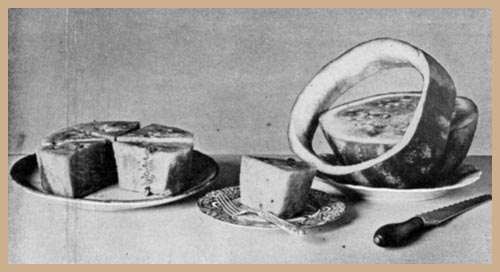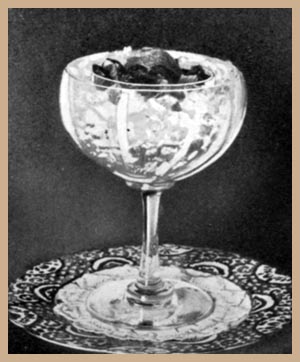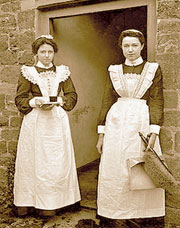Pallasweb.com Blog - Find the latest industry news, tips and tricks at Pallasart Web Design
Preparing and Serving Fresh Fruit
 Above: Watermelon served without Rind
Above: Watermelon served without Rind
The preparation of uncooked fruit for the table is usually classed with the duties of a butler, and thus is one of the things which a waitress is liable to be called upon to do, Certainly it is dainty work, in which she can take much pleasure. A few leaves inserted here and there between the fruit placed on the breakfast-table give an artistic touch that will be appreciated. Peach, apple, pear, cherry, strawberry, currant, and grape leaves can often be procured for use with these respective fruits. The leaves of the mountain laurel or of rhododendrons will keep for weeks in water that is changed daily, and their glossy surface improves the looks of any dish of fruit, but especially that of oranges and bananas.
Choice strawberries that do not require washing, but simply a gentle wiping with a soft brush, should be left unhulled. Small fruits and berries are injured by keeping in the refrigerator, and if on hand the night before, for service at breakfast, should be kept in a large open dish, that fresh air may circulate about the fruit. To prepare berries for the table, handle as lightly as possible. While looking them over, do not hold two or three in the hand at one time. Look at each one singly and set it aside. To free from sand, let water from the faucet run through the berries in a colander; let stand to drain, and serve at once. Wash all varieties of berries after hulling or looking over; they cannot be handled after being wet. Finger-bowls are passed after a service of fruit.
PREPARING GRAPE FRUIT
For Breakfast
Cut the grape fruit in halves across the grain, to form two portions. With a thin, sharp-pointed knife, a penknife is the best, cut around the pulp in each little section of the fruit, so that each triangular section of pulp can be freed from the surrounding membrane and lifted out with an orange spoon or fork. Also cut the membrane, separating the sections and the core from the skin, and remove all the membrane and core in one piece. Set the halves of fruit on plates with a small lace-paper doily between the fruit and plate. A spoonful of powdered sugar and sherry wine or Jamaica rum, or the sugar alone, is disposed in the centre, or, no addition is made to the fruit, according to the taste of those served.
GRAPE FRUIT, WITH MACEDOINE OF FRUITS
For a First Course at Luncheon
Prepare the grape fruit as for serving at breakfast, then for each half of grape fruit have ready about a tablespoonful of prepared fruit. A mixture of pineapple, fresh or canned, orange, and maraschino cherries is good. Brandied peaches may be used, when at hand, as also fresh white grapes, seeded and skinned. Mix the fruit, cut in small pieces, with liquid from the cherry bottle, sugar, or sugar syrup, and use to fill the open place in the centre. Decorate with maraschino cherries cut in quarters. For a change, omit the macedoine, and, just at serving, put a tablespoonful of sifted powdered sugar in the centre of each half fruit, and decorate with pieces of cherry, as before. Grape fruit is also used as a salad with lettuce and French dressing.
 SALPICON OF FRUIT, WALDORF-ASTORIA STYLE
SALPICON OF FRUIT, WALDORF-ASTORIA STYLE
Left: Salpicon of Fruit, Waldorf-Astoria Style
Make such a selection of fruits as is desired. Triangular pieces of pulp cut from halves of grape fruit, maraschino cherries, bits of pineapple, fresh strawberries cut in halves, brandied peaches cut in pieces, orange pulp, and slices of banana afford a choice. Chill thoroughly, then sprinkle lightly with sugar, and dispose in champagne glasses, set in larger glasses (on tall stems) filled with shaved ice. Serve as a first course at dinner or luncheon. These furnish a particularly pretty table decoration.
The pulp and juice of grape fruit daintily taken from the shell, that each piece may be in perfect shape, are often served in sherbet glasses, either with or without powdered sugar, as a first course at luncheon or dinner. For variation a tablespoonful of sherry or two maraschino cherries with a little of the syrup from the cherry bottle may be added.
SERVING WATERMELON WITHOUT RIND
Let the melon stand on ice several hours before serving; have the plates chilled also. Secure a section about four inches thick from the centre of the melon by cutting off from both ends. To serve more than eight, cut the melon, to give two sections of this thickness ; cut these sections, to leave the green portion in one piece and the edible portion a round of pink melon pulp in another. Place the edible portion on a dish of ample size. To serve this, cut it in triangles in the same manner as a pie.
 Above: Watermelon served from Half Melon
Above: Watermelon served from Half Melon
OTHER WAYS OF SERVING WATERMELON
Cut the melon in halves, crosswise. If it is to be served from the table, trim, if needed, that the half melon may stand firm on the plate, and dispose a few currant or grape leaves around it. To serve, with a tablespoon scoop out the pulp in egg-shaped pieces. Or, cut the melon in halves lengthwise. Scoop out the pulp from both halves in egg-shaped pieces, and use to fill one half the melon-rind. Garnish the plate with green leaves. The pink pulp of the chilled melon may also be taken out with a French potato-ball scoop in the shape of balls. Serve these in sherbet cups. Melon should always be thoroughly chilled.
SERVING MUSKMELONS
Have the melons thoroughly chilled. Wash the outside, wipe dry, cut in halves, and remove the seeds and stringy portion. Set the half melons on small plates covered with paper doilies. Pass sugar, salt, pepper, or cinnamon, as is desired. Bits of ice are occasionally placed in the hollow centre of the melon, but these are in the way during eating, and also detract from the flavor of the melon.The cavity of a melon filled with berries, shredded pineapple, or a spoonful of chopped oranges and bananas, is very good.




